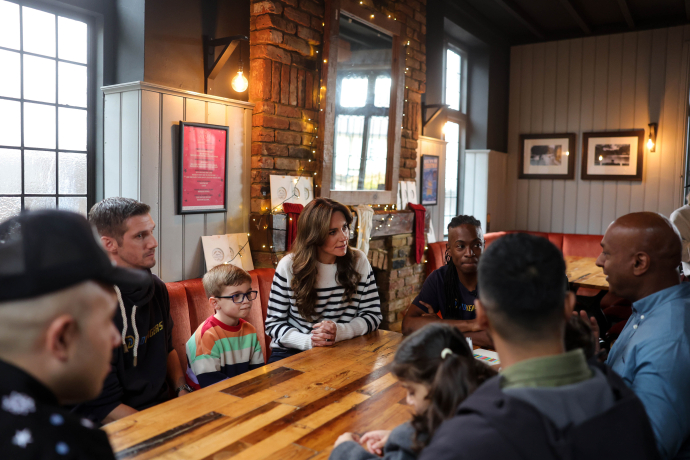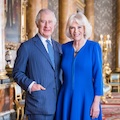New conjugal Coat of Arms for The Duke and Duchess of Cambridge
Published
The Duke and Duchess of Cambridge have a new Conjugal Coat of Arms which will represent them in heraldic terms as a married couple.
The Conjugal Coat of Arms was approved this year by The Queen and has been shown publicly for the first time today.
Designed by The College of Arms in London, Conjugal Arms traditionally show the separate shields of a Royal husband and wife, side by side.
The Duke’s shield on the left is his version of the Royal Coat of Arms granted to him by The Queen on his 18th birthday. On the right, The Duchess’s shield is from the Middleton family Coat of Arms, granted to the family in 2011 ahead of her marriage.
The Conjugal Arms will be theirs forever, however as their circumstances and roles alter, elements of the accoutrements around the shields may change. In addition to their Conjugal Arms, Their Royal Highnesses also retain their own Coats of Arms to represent themselves as individuals.
The Duchess of Cambridge was granted her own Coat of Arms by The Queen after her marriage. This was made by placing her father’s Arms beside those of her husband in what is known as an impaled Coat of Arms.
Heraldic Description of the Conjugal Coat of Arms
The shield on the left is taken from Coat of Arms granted to The Duke of Cambridge by The Queen on his 18th birthday. It shows the various Royal emblems of different parts of the United Kingdom: the three lions of England in the first and fourth quarters, the lion of Scotland in the second and the harp of Ireland in the third.
It is surrounded by a blue garter bearing the motto Honi soit qui mal y pense (‘Shame to those who think evil of it'), which symbolises the Order of the Garter, of which The Duke is a Knight Companion.
The Duchess of Cambridge’s shield on the right shows the Middleton family Arms, granted to her father Mr. Michael Middleton for the Middleton family in March 2011, prior to her marriage. The technical heraldic description of the Middleton Coat of Arms, known as a ‘blazon’ is Per pale Azure and Gules a Chevron Or cotised Argent between three Acorns slipped and leaved Or.
Per Pale means that the Shield is divided vertically with one half blue (Azure) and the other half red (Gules). A Chevron Or means the gold chevron across the centre of the Shield. There are cotises either side of the chevron which are white (Argent). Slipped means ‘with a stalk,’ so the final part of the blazon and distinguishing feature of the Shield means three acorns with gold stalks and leaves.
For its placement in the conjugal Arms, The Duchess of Cambridge’s shield is surrounded by a Wreath of Oak, to balance out the Duke’s garter. This is traditional for Royal Spouses who are not themselves entitled to surround their Arms with an order of chivalry.
Both shields are supported by The Duke of Cambridge’s Supporters of the Royal Lion and Unicorn wearing a three pointed collar, known as a label. The label has a red escallop shell derived from the Spencer Coat of Arms which has been used by The Duke's ancestors on his mother's side for many centuries.
Related content



The Duchess of Cambridge marks 5th anniversary of London Baby Bank Little Village


A speech by The Duke of Cambridge at Kensington Memorial Park
I am delighted to dedicate Kensington Memorial Park as a Centenary Field

The Duchess of Cambridge has been admitted to St. Mary’s Hospital in the early stages of labour
The Duke and Duchess of Cambridge are expecting a baby in April
The Duke and Duchess of Cambridge are expecting their second child
The official photographs of the Christening of Prince George
The Duchess of Cambridge has been admitted to St Mary’s Hospital in the early stages of labour
The Duke of Cambridge is appointed Knight of the Most Ancient and Most Noble Order of the Thistle by The Queen
A speech by The Duke of Cambridge in Yellowknife, Northwest Territories, Canada
It's great to be here North of 60.


